
 |
|
|
|
Well, my review of this long-awaited disc set is finally up. It's not exactly timed for the product's street date, but I hope it will compensate in quality. Universal's horror classics have never waned in popularity. Smash hits in the Pre-code Depression days, they weathered the enforcement of Catholic-dominated censorship system dedicated to their suppression. A trial re-issue of horror classics in the late 1930s led to a new wave of '40s productions, and even after further reissues licensed to Realart, interest did not diminish. The 1956 release to television re-ignited the legend of Dracula and Frankenstein, and by the early 1960s a full wave of juvenile monster mania had gripped the baby boomer generation, with magazines, plastic kits and 8mm digest samplers. But through it all the films themselves were trapped in 16mm TV prints that didn't convey the care and creativity with which they were made. Murky, blurry images on TV were all we could see. To admire the monsters in detail we had to reference republished still art of the fantastic Jack Pierce makeups. Through many home video reissues the Universal monsters have been steadily improved. But this newest release (resurrection?) collection exhibits a dramatic jump in quality. Remastered in Blu-ray, the eight top titles in the Universal Classic Monsters The Essential Collection have seen untold hours of cleanup and restoration work. HD means High Definition, which becomes immediately apparent when these visions hit the screen. The images are sharp and clean and stabilized -- no more jumps at cuts or the feeling that static scenes are 'floating' in the frame. Close-ups reveal more makeup detail, and the enhanced contrast ratio brings out the beauty of the original cinematography -- mists, textures and contextual details are now more visible. Even the cobwebs in Dracula's lair have more 'personality'. Universal has been producing special edition extras for their top-rung monster epics for over ten years now, and all of the best commentaries, featurettes and full-length documentaries have been included. Topping the list of notable bonus items are two alternate feature presentations, the concurrently filmed Spanish-language version of Drácula and a brand-new 3D encoding of Creature from the Black Lagoon, which was one of the best and most effective 1950s 3D features. The movies are familiar to most viewers so I'll make my remarks on them brief before describing my reactions to the new Blu-ray restorations. Somewhere in the studio's history, Universal awakened to the realization that their classic monster series is a cultural treasure and perhaps their most commercial fully-owned asset. Meanwhile, the legions of fans of Universal monsterdom have long concluded that many of the movies, especially those by James Whale, qualify as works of legitimate cinema art. The Universal Classic Monsters Essential Collection lavishes respect on this heritage of chills from the past. Universal released its share of silent films with horrific themes, which at the time were dominated by haunted house horror-comedies. There is of course the 1925 Phantom of the Opera, Lon Chaney's most impressive 'monster' role. Carl Laemmle imported European art director-director Paul Leni, who made the popular macabre hits The Cat and the Canary and The Man Who Laughs. Both bear strong traces of the later Universal "house style" for horror. 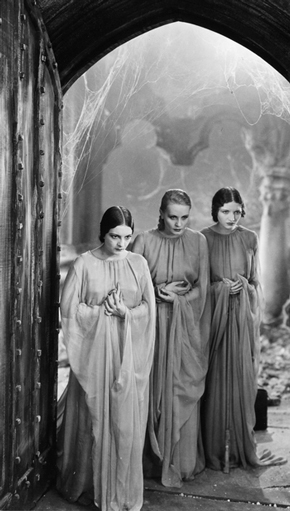
Carl Laemmle Jr. took the studio in a startling new direction with Dracula, the tale of the vampire king who relocates from Transylvania to London which shot Bela Lugosi from unknown status to stardom. The strong story and eerie visuals overcome specialist Tod Browning's less-than-inspired direction of many scenes. Whenever the story settles on the stage-bound dialogue exchanges the movie slows to a crawl. Uni's new transfer makes the most of the film's stunning visuals in Transylvania. We all know that the original Dracula refrains from showing any actual neck-biting, but Browning shies away from anything stronger than suggestions of horrific content. Dracula's vampire brides are barely seen, and when they close in around their victim we can't be sure exactly what they are up to. Lugosi doesn't get to use his expressive hands very much: the show relies heavily on giant pale-faced close-ups with special lights rigged to make his eyes look as if they were glowing. Lugosi's unique Hungarian voice and commanding personality compensate for what is a mostly static production -- people seem to talk and move in slow motion. The main fringe benefit is Dwight Frye as Renfield, the vampire's pathetic slave. Renfield is an over-the-top stage madman expressing a delightfully unrestrained fiendishness -- the frightening grin, the crazed staring eyes: "Who wants to eat flies? Not when I have nice fat spiders!" All of the Transylvania-based scenes are greatly improved on the Blu-ray -- mists and fogs are no longer video smears but expressive wisps of smoke that lend depth to scenes. We're left to assume that Browning equated slow sobriety with 'the horror of the grave', an idea with merit that doesn't extend to the dialogue scenes. As it turns out, Tod Browning seems to have cut corners on the 'action' scenes in Dracula, for reasons we can only guess. This is because the Spanish language version Drácula, filmed at night on the same sets with a Mexican, Spanish and Argentine cast, follows the script more closely. It has more shots, more camera moves, more dynamic angles and more on-screen 'business', especially at the film's conclusion, where Browning's version seems to want to get the show over with as soon as possible. An 'extra' in the Essential Collection, Drácula lacks only Lugosi; it's a shame that the actor wasn't induced to work a double shift and read his lines phonetically -- if his salary were doubled, he'd surely have jumped at the opportunity. Drácula is unfairly slammed for the 'hammy' performance of Carlos Villarías, who is simply playing the Count as the fiendish ghoul he is. Famed Mexican actress Lupita Tovar describes the Latin way of performing as more emotional, and with the exception of Renfield, all the characters are more lively in the Spanish version. Although a couple of the Latin actors are just as limp as their English-language counterparts, the women are far more interesting and sensual. The foreign versions presumably had no code restrictions, which accounts for the much more provocative costumes. The 'possessed' Eva (Tovar) comes on to her confused swain Juan like a real hussy, and even bites his neck -- behavior even less acceptable in upscale Latin culture than in ours. The vampire brides back in Transylvania are more demonstrative as well. Only the stagebound scenes slow to a crawl. Perhaps imitating the style of the English version, the Spanish dialogue is even more drawn out, with huge pauses between lines. The editor in this viewer wants to go to work tightening things up in both films... which would of course be cinematic blasphemy. 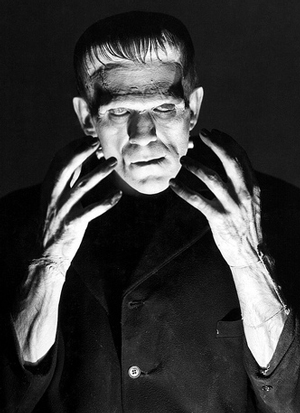
By contrast, 1931's Frankenstein is world-class filmmaking. Seen uncut (we '50s kids were deprived of several scenes of torture and cruelty), with its blasphemous dialogue intact, James Whale's picture expresses much of the intent of the original Mary Shelley horror tale. Frankenstein's Monster is not a monster at all, but an allegory for the human condition: expressing the idea that we've been abandoned by the God that made us. "Criminal Brain" or no, the Monster begins his new life as an innocent, only to be taught brutality and murder through hostile treatment and a withholding of parental love. The most expressive moment in classic horror occurs when the Monster reaches up at a beam of sunlight, and stretches his hands out, as if hoping that angels or God himself will acknowledge him. It's the primal image of faith and prayer, a humble and hopeful appeal for love. We are the Monster when we ask, why must I be so horribly alone? Boris Karloff's portrayal of the Monster is one of the three or four best-mimed performances in film history, and the makeup design surely the most famous ever. If we look beneath the cultural associations, we see in Karloff's face the face of death, of a mournful walking corpse. James Whale steers away from the original book's almost De Sade-like insistence on 'horribleness', to include the touching scene with the child Maria. Whale doesn't have much positive to say about science, as the 'brilliant' Henry Frankenstein is a neurotic incapable of dealing with his own creation. Frankenstein seems like any father who can't relate to his child, that he sees as a reflection of his own failure instead of an innocent creature needing and deserving his love. Artificial beings like Whale's Monster are not 'made by God' and therefore have no souls, or so say a lot of conservative literary precedents: robots, Golems, seductresses born of artificial insemination. But Whale's Monster clearly has a soul. Frankenstein is a disturbingly subversive masterpiece that transcends the horror category. The restoration of material censored from Frankenstein happened quite a while ago (the 1980s?). We monster fans were surprised to see Fritz (Dwight Frye) finally pay the price for tormenting the Monster, and the uncut scene with Little Maria that makes the Monster out to be a fumbling innocent instead of a child molester. We were also impressed when Henry Frankenstein's censored dialogue line was restored: Oh, in the name of God! Now I know what it feels like to be God! An earlier DVD upped the contrast in the image and filtered all of the surface hiss out of the dialogue, leaving the soundtrack mostly silent. The new Blu-ray rethinks the entire picture for the improved contrast range of HD, pulling more character from the images and smoothing out the transitions to the formerly censored scenes. Frankenstein now plays so beautifully that even the hammy scenes with Henry's father back home are enjoyable. 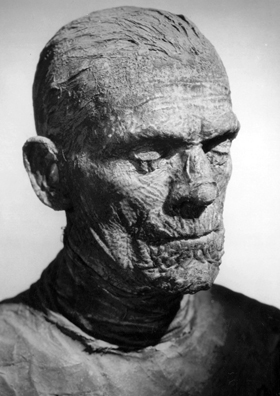
1932's The Mummy sees Boris Karloff at his height, billed above the title; a smart actor who avoided exclusive contracts, he'd also worked at MGM on The Mask of Fu Manchu. Often disparaged in print, even by some top genre critics, The Mummy is designed to make the most of a slow, sepulchral mood. The storyline is a beautiful macabre romance: the 3700 year-old mummy Imhotep (Karloff) returns to claim the reincarnation of the woman he loved in the time of the Pharoahs. Under his spell, the modern woman bearing the immortal soul of Anck-es-en-Amon, Helen Grosvenor (Zita Johann) falls in love with Imhotep, but balks when he explains that everlasting love must begin with a 'momentary' death beneath a sacrificial knife. Director Karl Freund pulls out every ounce of necromantic atmosphere from the excellent prop work, while Karloff is mesmerizing as the revived mummy, who has a complexion seemingly made of ancient dust. The famous Jack Pierce mummy makeup is unforgettable, even though it is seen only in four or five nearly static cutaways. With flashbacks to ancient Egypt conveyed through a TV-like reflecting pool, The Mummy may be the first 'classic' horror film to use a 'monster' music theme cue: when Imhotep raises his ring to hypnotize or cause heart attacks by long distance, a rising series of musical notes (dig those warbling clarinets!) reinforces his power. Except for a title tune and incidental music, both of the previous horror outings had no music scores at all. The Mummy always looked light and somewhat soft on home video, while the opticals showing the ancient scenes were contrasty, with a visible flicker. Unstable splices caused a bounce effect on cuts, which worked against the film's crypt-like trance. On the new Blu-ray you'll want to freeze the frame every time a new close-up of Karloff hits the screen. They're simply amazing. I can see Freund, Karloff and cameraman Charles Stumar spending a full day just perfecting the cutaways of Imhotep in his casket, coming to life as the unlucky Bramwell Fletcher recites from the Scroll of Toth. One close-up of the Fez-wearing Imhotep is repeated several times in the second half of the film, the choker shot that fixates on the staring eyes in the very dark eye sockets. In some shots these eyes are made to glow, quite unnervingly. Previous to now I always thought that the shots were made from a still photo, as Karloff doesn't seem to move. But the Blu-ray reveals that they are live action shots -- Karloff is moving almost imperceptably. The effect is very, very creepy. 
James Whale had already proved that he could mix comedy and scares in The Old Dark House, and his adaptation of The Invisible Man filters the essence of H.G. Wells' science fiction story through a truly twisted sense of humor. The adaptation solves a number of tough problems - John P. Fulton's clever traveling mattes sell the notion of invisibility, and actor Claude Rains' superb vocal performance is so rich that we don't miss not seeing his face. Whale has great fun with the unique idea of invisibility, taking advantage of the comic possibilities among the denizens of an English pub. But the dire threats of the murderous, invisible Griffin become very real when he tosses a baby buggy upside down while tearing through a busy street. The later scenes of the invisible terrorist being traced and cornered in the snow are completely serious. Fans of Whale and Wells are usually delighted by this adaptation. I was able to see The Invisible Man projected in a special showing last August for the AMIA's The Reel Thing convention. The movie was in such poor shape Universal worked with Technicolor Creative Services to piece it together. Here's what I wrote about the restoration: "The last presenter up was Tom Burton of Technicolor, who has an entertainer's streak and entered the Linwood Dunn theater dressed as The Invisible Man, with his head wrapped up, a fedora tight around his ears and wearing old-fashioned dark glasses. He then proceeded to explain (well, after removing his disguise) the back-flips TCS performed to fix some of the film's worst problems. I'd heard quite a bit about the sorry state of this title, which has had all kinds of problems ever since I started seeing it as a small child -- problems way beyond the usual fuzzy picture and hissy sound. As the original negative is long gone and few film elements still exist, the prognosis wasn't good. Universal has a fine-grain dupe of this title. It has the usual digitally-repairable damage, but also serious issues all the way through, most notably scores of instances of missing frames that screen as black dropouts anywhere from 1 to 8 frames in length. A problem with splices on almost all the cuts caused frames just before and after cut points to be out of focus, as well. The only other useful film element was another copy in England, but it had its own kinds of damage, including bad deterioration stains in certain areas. Technicolor ended up borrowing frames from the English copy to patch the missing bits in their American fine grain (not on film, just digitally). The separated films had shrunken differently over time. They had to be aligned and tweaked to fit, and then timed and processed to create a visual match. The screening that followed looked far, far better than any of us hoped The Invisible Man could ever look. Because of the tools now available, these once-impossible problems just go away... the flaws that constantly popped up before, practically on every cut, disappear. One set of five missing frames happens in a wide scene of actor Henry Travers buying a newspaper on the street, among a group of people. The Brit copy was stain-damaged through this entire section, so an image swap was a no-go. But the camera is static in the affected patch, so TCS pieced together a full people-less background, and then cut and pasted just the human figures from the Brit copy. I imagine that making it all match and flow took some time, but that problem is now 'invisible' as well. It's true that cleaning up the picture, evening out the contrast and eliminating flicker (probably the wrong term) goes about 90% of the way to making an 80 year-old show like this look brand new. I yanked out my older DVD of the title as soon as I got home to verify that the problem spots Tom Burton showed us were as advertised -- and yes, right in the middle of Griffin examining the signpost to Ipping, frames are missing. The sound restoration is almost as good. Now every dialogue line is clear, even with the British accents. And neither picture nor sound has the feel of being processed, optimized for home HD sets or sanitized of all surface noise -- the filmic dimensionality of people and objects has been retained. I did see a few hints of the wires used to manipulate some objects... the wires hadn't been removed digitally (very good call) but they were all but invisible anyway. It's just a super, super restoration of a film we know and love. Claude Rains is nothing short of fantastic and it is rather magical seeing the young Gloria Stuart, sixty-four years before her victory-lap appearance in James Cameron's Titanic." 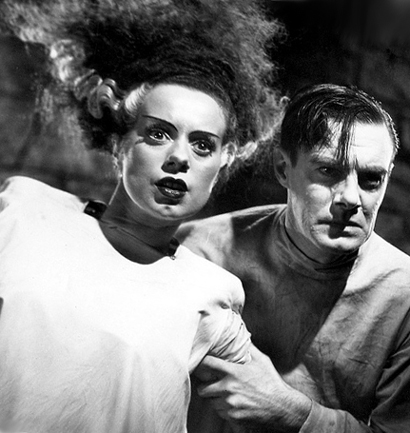
1935's The Bride of Frankenstein sees James Whale jumping artistically way beyond the perceptions of the audience, not to mention his own employers. The oft-delayed sequel to Uni's biggest monster hit is a brilliant piece of entertainment that plays as a completely demented satire of itself. Yet many scenes carry an emotional sincerity found nowhere else in horror. Whale juggles and balances a tall stack of odd content and self-aware references: operatic excess, melodramatic plotting, black humor, necromantic humor, political comment, anti-clerical jabs, parodies of classical paintings, German Expressionistic sets, Russian montage editing and pure cornball sentiment. We've got the neurotic Baron Frankenstein (nervous Colin Clive once again) paired up not with his own bride but with the insinuating, proto-Camp Dr. Pretorious (the imperious, insinuating Ernest Thesiger). Pretorious presents his own collection of perverse little homunculi "grown from seed". They include The Devil and a Mermaid, but also a little King Henry the 8th, trying to assault his equally little Queen while a disapproving miniature Bishop waves his arms and blows a whistle. John Fulton's complex multiple mattes make the sequence work beautifully; Whale must be aiming his satire at Hollywood's own Catholic-dominated censors. The movie shifts tone 180° with every scene, yet remains a cohesive statement. Scarred and burned, Karloff's Monster talks, which makes him a more interesting presence and a richer character. It's too bad that further entries in the Uni Frankenstein series demoted the Monster back to brute mute status. The goofy prologue with Shelly, Byron and Mary (Elsa Lanchester) talking about the 'sequel' to her horror story sets the show off on an eccentric pattern that never lets up. The key to Whale's inspired lunacy is that all the characters and scenes are direct and sincere. As soon as the Monster meets the kindly blind hermit (O.P. Heggie) we shift into a strong sentimental mode -- we laugh when the Monster smokes a cigar, but we are also moved to see him find a kind friend who teaches him peace and understanding (not to mention simple Christian values). Whale caps his show with a musical tour-de-force. The mad-lab creation of The Bride is cut metronome-style to the insistent beat of Franz Waxman's bona fide schizophrenic music score -- the stomping beat combins with a soaring melody to represent the "promise" of a female monster. When we finally see the Bride, she's a truly fantastic creation -- a stylishly scarred mad creature. We're told that numberous Whale ideas and even film sequences had to be tossed over censor objections, but what's here is something radically apart from 'normal' Hollywood filmmaking: aesthetic shock treatment. The Bride of Frankenstein has looked pretty sad, both on home video and on old 16mm prints, some of which had oddball splices marring important scenes. An earlier DVD had fans fuming, with a poorly framed transfer that cropped the picture too tightly, almost eliminating the cross that lingers at the end of the meeting of the Monster and the hermit. The new Blu-ray eliminates the problems and smoothes out the film's eccentric opticals, like the series of rapid dissolves at the beginning of the Byron-Shelley prologue. A big plus is the beefier BD audio, which gives us a better rendering of the Wazman score during the deliriously excessive creation sequence. 
The set skips ahead six years. In the late '30s the Production Code discouraged the making of horror films, as they persisted in promoting dangerous themes antithetical to the God/Uncle Sam/Apple Pie fantasy film world the censors wanted to prevail. I'd say that Dracula's Daughter and Son of Frankenstein might certainly qualify for this box, but then one would have to consider the equally important Karloff-Lugosi picture The Black Cat. as well. In 1941 Uni's second attempt at a werewolf story The Wolf Man sought to promote Lon Chaney Jr., who had recently received good reviews in the film version of Of Mice and Men. The show is almost top-heavy with acting support for Lon. Claude Rains, Maria Ouspenskaya, Bela Lugosi and Ralph Bellamy back him up and Evelyn Ankers provides a lovely girlfriend figure. Improvements in film stock result in an even richer image than the earlier films, and the impressive sets come across well -- lots of trees, lots of stage fog. Curt Siodmak created an entire werewolf lore for the picture that proved so popular that it is assumed to be from an older tradition -- silver bullets, silver canes, a gypsy reciting a sad poem, pentagrams that appear in palms. Although a classic title and a fan favorite The Wolf Man doesn't have the depth of the earlier pictures; the story is perfunctory and director George Waggner has no ambition beyond surface thrills. The central character of Larry Talbot has no thematic or psychological link to his affliction; he's just a nice guy in the wrong place at the wrong time. What point is an evil curse, if its victim is chosen so arbitrarily? Although not very wolf-like, Jack Pierce's wolf man makeup is definitely photogenic. Lon Chaney is properly feral when prowling the moors in tiptoe (and reportedly tripping on all the pipes laid to spread the "fog"). Chaney also does a serviceable job as a frustrated and pathetic victim of lycanthropy. Yet ace actor Claude Rains naturally outshines him. 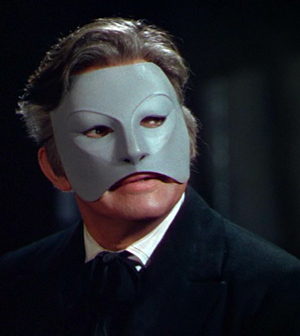
The studio must really have liked Claude Rains, for in the middle of the war it produced a lavish Technicolor remake of the classic Phantom of the Opera with Rains playing Erique Claudin, the title Phantom. The irritating thing is that horror takes a back seat to the spectacular opera scenes and the colorful costumes, with Susanna Foster and Nelson Eddy given higher billing. The screenwriters flatten out the story to make The Phantom less a maniac-fiend than a pathetic victim -- he's a violinist-composer who thinks his work is being stolen by an unscrupulous publisher. Scarred with printer's acid, Erique retires to the familiar bowels of the Paris Opera house and promotes his own singing favorite to star, while raining disaster on a stubborn diva who ignores his threats to step down. Since this is Technicolor, a simple black cloth mask will not do -- Erique wears a slick green designer job. Claudin's subterranean lair and his ghostly activities seem far less mysterious than in the Chaney silent version, but the Phantom's main set piece of murder is retained. What could be more satisfying than dropping a heavy metal chandelier onto a helpless audience of swells, dressed to the teeth? Orchestra seats all, rows 8a through 14b. Enjoy the show! The horror element is so suppressed as to not be present at all. Claudin is seen mostly as a shadow on the wall and his murders occur off-screen. Even the chandelier disaster is shot in such a way as to omit shots of the aftermath. Rains is good, but his pathetic madman character isn't all that interesting. This Phantom never gets the chance to be a righteous fiend. Given the famous title, a good Claude Rains performance and Technicolor, it's only natural that the 1943 Phantom of the Opera be included in this boxed set. The show has always looked good on home video, with typically bright colors; on Blu-ray it's much the same. The increased contrast range now makes the sparkle reflections from jewels and eyes even brighter; Technicolor softened grain but some close-ups seem so clean that we wonder if noise reduction has smoothed them out. One type of flaw persists -- in the Eastmancolor composite source made from the Technicolor separations, a number of shots have registration problems. This typically is seen as a slight halo of green around Susanna Foster's hair in some close-ups. The only obvious problem shot shows the soon-to-be-murdered diva walking and smiling -- her face is just small enough that the mis-registration seems to rearrange her facial features. It's over in about 1.5 seconds -- this is not a major defect. 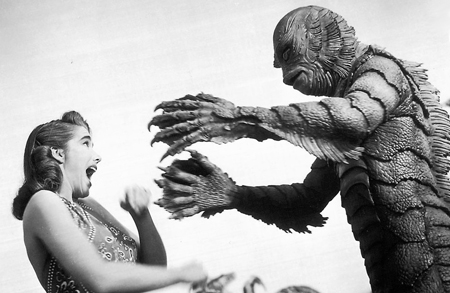
The collection closes with another 12 year leap, direct to the '50s Sci-fi hit Creature from the Black Lagoon, which is perhaps the last great Universal movie monster on record. The Gill Man starred in three aquatic monster romps, the first two of which were filmed in 3D. The Essential Collection contains both flat and 3D encodings of this perennial crowd pleaser, making the set even more desirable for first adopters. The depth effects are very clean and the illusion of 'being there' fascinating. Creature is an excellent 3D outing, particularly in the underwater scenes where the title character swims in a fully-realized depth environment, with floating debris seemingly hanging in the space in front of the viewing screen. Creature claws project into our faces numerous times during the film, accompanied by a blaring-trumpet monster fanfare used similarly to the one heard way back in The Mummy: Dah da da DAHHH! Opening the show is a 3D explosion representing the creation of the universe, which could very well be an outtake from It Came from Outer Space. Sort of a space age scientific answer to gothic horror, the Creature is one cool dude, blessed with a scaly design that still hasn't dated. Although his movie vehicles were never quite good enough for him, the Gill Man is a keeper, even in his two sequels. Viewers that have been watching Creature flat on TV for fifty years will feel like they're looking at a new movie. Both the flat and 3D encodings matte the image to the original theatrical widescreen Aspect Ratio, resulting in a more modern look. Compositions are tight and scenes using rear projection no longer look so artificial. The cropping eliminates glimpses of telephone poles visible at the top of the frame, that were once claimed as errors. Now more prominent than ever are what look like the vertical pipes of a church organ right in the middle of the Gill Man's underground lair. As I once joked, perhaps the Creature was once roommates with the Phantom of the Opera. The Blu-ray of Universal Classic Monsters The Essential Collection is a classy presentation on all counts. The sturdy box packaging contains a very nicely appointed 46-page souvenir booklet with the rundown on the films and bios of the top horror stars and effects people. Even as an over-informed fan of these pictures I found the text and images very pleasing. Tom Weaver wrote the opening essay, which covers all bases in appropriate fashion; although I'm still smarting from his pun about the Universal monsters "never having been licked" except when they were issued as postage stamps. (Positively genial on most subjects, Tom is not a fan of the Hammer Films that retraced Uni's steps in the late 1950s, in blood-red Technicolor.) The disc holder is a dependable-looking accordion affair, with more full color photos, posters and text, along with lists of disc contents. All the extras are repurposed from the previous releases except for the Restoring Dracula featurette and the mini-docus on the history of Universal, which have appeared on other Centenniel releases. Expert commentaries proliferate, with the particpation of Tom Weaver, Sir Christopher Frayling, Rudy Behlmer, Scott MacQueen, Rick Baker and Steve Haberman. As they were produced back when the studios were expending real effort with Added Value content, the quality of the docus and featurettes is high. The early titles all carry long-form documentaries, often interviewing key actors. The legendary Lupita Tovar, going strong at 101 years old, introduces the Spanish Drácula. The discs have trailers, galleries of stills and posters. An accounting of extras:
Dracula
Frankenstein
The Mummy
The Invisible Man
The Bride of Frankenstein
The Wolf Man
Phantom of the Opera
Creature from the Black Lagoon On each disc: Archives with promotional art, production stills, etc.; Trailer and trailer galleries
On a scale of Excellent, Good, Fair, and Poor,
Reviews on the Savant main site have additional credits information and are often updated and annotated with reader input and graphics. Also, don't forget the 2011 Savant Wish List. T'was Ever Thus.
Review Staff | About DVD Talk | Newsletter Subscribe | Join DVD Talk Forum |
| ||||||||||||||||||